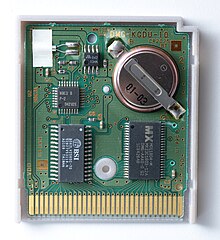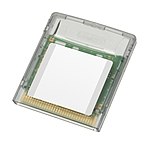Game Boy Game Pak
 Game Boy Game Paks from left to right: original, Color, Advance | |
| Media type | ROM cartridge |
|---|---|
| Encoding | Digital |
| Capacity |
|
| Standard | Proprietary |
| Developedby | Nintendo |
| Dimensions |
|
| Usage | |
| Released |
|
| Discontinued |
|
Game Boy Game Pakis the brand name of theROM cartridgesused to store video game data for theGame Boy familyof handheld video game consoles, part of Nintendo's line ofGame Pakcartridges. Early Game Boy games were limited to 32kilobytes(KB) ofread-only memory(ROM) storage due to the system's8-bit architecture.Nintendo later incorporated a memory bank controller into cartridges to allow for more storage byswitching between ROM banks.This change allowed Game Paks to reach 8megabytes(MB) of storage, allowing for more complex games.
In addition to ROM, cartridges could also includerandom-access memory(RAM) chips that could be used for increased performance or to save game progress. A battery in the cartridge would keep the RAM powered when the Game Boy was off. Later cartridges could also includereal-time clockfunctionality that could keep track of time even when the device was off or aRumble Pakto add vibration feedback to enhance gameplay.
Game Paks for theGame Boy Advance,which uses a32-bit architecture,could accommodate up to 32 MB of game ROM. The Game Boy Advance was the last major handheld device to use cartridges as its primary storage format. Later systems, like theNintendo DSandNintendo 3DS,use game cards, which are similar toSD cards.
Background
[edit]Original and Color
[edit]
(Annotated version)
The Game Boy Game Pak cartridges store the game's code and data using ROM chips. However, the original Game Boy's 8-bit architecture limited the CPU's access to just 32 KB of ROM at a time, restricting early games to this size.[2]
Nintendo overcame this limitation with a chip called the memory bank controller (MBC) placed within the cartridge. A similar solution had been by previously used on theNintendo Entertainment System Game Pak.The MBC chip acts like a traffic controller, switching between multiple banks of 32 KB each. Using this technology, Nintendo was able to create cartridges that used up to 8 MB of ROM,[3][4]vastly expanding game size and complexity.
Some Game Boy cartridges included random-access memory (RAM) to increase the device's performance and allow game progress to be saved. This memory typically came in the form of an 8 KBEEPROMchip, a 32 KBSRAMchip, or later, a 128 KBflash memorychip. SRAM chips required a battery to retain data when the Game Boy was powered off. These batteries had a limited lifespan and needed to bedesolderedfor replacement. The SRAM chips were later phased out in favor of the flash memory chips, which can store data without the need for a battery.[3][5]Later revisions introduced even more functionality. Real-time clock capabilities kept track of time using acrystal oscillator.[6]Rumble Pakcartridges added vibration feedback to enhance gameplay.[3]
The standard cartridge measured 5.8 centimeters (2.3 in) wide and 6.5 centimeters (2.6 in) high. However, some games, such as theGame Boy Camera,boasted custom-designed, larger casings to accommodate special features. On the original Game Boy a plastic tab slid across into a notch at the top of the cartridge when the console was powered on. To save space, this locking mechanism was removed from all subsequent devices. The notch was not present on Game Boy Color Game Paks to prevent them from being used in the original Game Boy. If these Game Boy Color Game Paks were inserted into a Game Boy Pocket or Light, an error message would be shown on the screen.[3]
Advance
[edit]
The Game Boy Advance used a significantly shorter standard cartridge design at 3.5 centimeters (1.4 in) high. The top of the cartridge was wider at 6 centimeters (2.4 in) wide to prevent insertion into older Game Boy devices, but the bottom retained the same width of 5.8 centimeters (2.3 in).[7][better source needed]
The Game Boy Advance Game Pak could accommodate up to 32 MB of game ROM, although specialGame Boy Advance Videocartridges could hold 64 MB of video on ROM.
Cartridges could also include RAM, however these were mostly used to save game progress and not to increase the device's performance.[8]This memory typically came in the form of an 4 or 64 KBEEPROMchip, a 256 or 512 KBSRAMchip, or later, a 512 KB or 1 MBflash memorychip. SRAM chips required a battery to retain data when the Game Boy was powered off. These batteries had a limited lifespan and needed to bedesolderedfor replacement.[5]
Game Boy Advance cartridges included notches on the cartridge's corners. When inserted into a Game Boy Advance, these notches avoid pressing a switch (called a shape detector) within the slot, allowing the device to boot into its native mode. When an older Game Boy cartridge was inserted, this switch would be pressed, triggering the device to boot into its backward compatibility mode.[8]
The Nintendo DS retains backward compatibility with Game Boy Advance cartridges but not older Game Boy games. To accomplish this, the button was replaced with a solid piece of plastic, preventing older Game Boy cartridges from fully inserting.[citation needed]
Types
[edit]Excluding game-specific variations, there are four types of cartridges compatible with Game Boy systems:
Original Game Boy Game Pak
[edit]
The original Game Boy Game Pak (also known as class A or grey cartridges) is compatible with all Game Boy systems, excluding Game Boy Micro. All original Game Boy games are of this type. The games on these cartridges are programmed in monochrome (using four shades of grey or green).
When these games are played on the Game Boy Color and subsequent systems, the device applies a limited color palette (typically dark green) using four to ten colors to enhance games originally intended to be presented in four shades of gray. Many games were programmed to call for a default color palette.[9][10][11]However, for games without a default, users could choose from 12 different palettes using button combinations.[12]A dedicated palette option replicates the original Game Boy's grayscale experience.[13]
Additionally, a limited number of cartridges released between 1994 and 1998 feature enhancements compatible with theSuper Game Boy.
Although most original Game Boy Game Paks were encased in grey plastic, some used special colors that match the game's theme, including notably,Pokémon Red,Blue,andYellowand theDonkey Kong Landseries, which utilized yellow cartridges.
Color-enhanced Game Boy Game Pak
[edit]
The color-enhanced Game Boy Game Pak (also known as class B, dual mode, or black cartridges) improved the gameplay experience on the Game Boy Color and subsequent systems while maintaining compatibility with older monochrome devices.
These cartridges can use the full color capabilities of the Game Boy Color and subsequent systems, displaying up to 56 colors simultaneously out of a palette of 32,768 while use up to 56 colors out of a palette of 32,000 while remaining compatible with the original Game Boy where they were presented in four shades of gray. However, this compatibility comes at the expense of not being able to utilize the handheld's increased processing speed and memory.[12][14]
Some color-enhanced games, likeWario Land IIandThe Legend of Zelda: Link's Awakening DXwerecolorizedre-releases of originally monochrome games, however, Nintendo insisted that developers include gameplay enhancements (beyond simply adding color) to differentiate the games from their monochrome counterparts.[3]Some color-enhanced cartridges also boasted features later seen in clear cartridges, such as the Rumble Pak inPokémon Pinball[15]and infrared communications inRobopon Sun, Star, and Moon Versions.
Although most color-enhanced Game Boy Game Paks were encased in black plastic, some used special colors that matched the game's theme, including notablyPokémon YellowandPokémon GoldandSilver.
Game Boy Color Game Pak
[edit]
The Game Boy Color Game Pak (also known as class C or clear cartridges) introduced unique features for players on the Game Boy Color and subsequent systems. They boast a wider color range (up to 56 colors) and benefit from the increased processing speed and memory introduced with the Game Boy Color. Because of this reliance on the newer hardware, these games are incompatible with the older monochrome Game Boy models.[16]
Certain cartridges also had additional features to enhance gameplay, including rumble feedback, utilized inPerfect Dark,and tilt sensors, employed inKirby Tilt 'n' Tumble.[17]
Most original Game Boy Game Paks were encased in translucent plastic, but similar to previous generations, some were released in special colors that match the game's theme, like Pokémon Crystal.
Game Boy Advance Game Pak
[edit]
The Game Boy Advance Game Pak (also known as class D cartridges) is half the size of all earlier cartridges and is compatible withGame Boy Advanceand later systems, including the Nintendo DS.
Some Advance cartridges have built-in features, including rumble features (Drill Dozer),[18]tilt sensors (WarioWare: Twisted!,Yoshi's Universal Gravitation)[19]andsolar sensors(Boktai).[20]
Although most Game Boy Advance Game Paks were encased in dark grey plastic, some used special colors that matched the game's theme, including notablyPokémon Emerald.
References
[edit]- ^"Consolidated Sales Transition by Region"(PDF).Nintendo. April 26, 2016. Archived fromthe original(PDF)on October 11, 2016.RetrievedOctober 23,2016.
- ^Copetti, Rodrigo (February 21, 2019)."Game Boy / Color Architecture – A Practical Analysis".Copetti.org.Archivedfrom the original on April 13, 2024.RetrievedApril 29,2024.
- ^abcde"Game Boy Programming Manual"(PDF).December 3, 1999. p. 299.RetrievedApril 30,2024.
- ^Byers, Brendan."Exploring the Gameboy Memory Bank Controller".Brendan's Website.Archivedfrom the original on April 29, 2024.RetrievedApril 29,2024.
- ^abZiegler, Reiner (2008)."ROM cartridge interface".Archivedfrom the original on November 27, 2023.RetrievedMay 3,2024.
- ^Javanainen, Joonas."Game Boy cartridges".Game Boy hardware database.Archivedfrom the original on May 10, 2024.RetrievedMay 3,2024.
- ^"What are the Game Boy Advance (GBA) Game Pak ROM cartridge physical dimensions (length x width x height)?".Arqade.Archivedfrom the original on May 5, 2024.RetrievedMay 5,2024.
- ^abCopetti, Rodrigo (August 18, 2019)."Game Boy Advance Architecture - A Practical Analysis".Copetti.org.Archivedfrom the original on September 4, 2022.RetrievedMay 5,2024.
- ^Paternostro, Emi (June 29, 2023)."Game Boy Color Modes".GB Studio Central.RetrievedMay 27,2024.
- ^"Notes:Game Boy Color Bootstrap ROM - The Cutting Room Floor".tcrf.net.RetrievedMay 27,2024.
- ^"Game Boy Color boot ROM".GitHub.RetrievedMay 27,2024.
- ^abDay, Ashley (2016).Videogames Hardware Handbook.Vol. 1 (2nd ed.). Bournemouth:Imagine Publishing.pp. 236–239.ISBN978-1-78546-239-9.
- ^"Changing the Color Palette on Game Boy Advance Systems".Customer Service.Nintendo.Archivedfrom the original on January 13, 2009.RetrievedJanuary 4,2009.
- ^"Disassembling the GBC Boot ROM".Archivedfrom the original on December 3, 2020.RetrievedAugust 13,2020.
- ^"Why Game Boy Color games with the built-in rumble feature were the coolest".The Diamondback.Archivedfrom the original on July 9, 2018.RetrievedJuly 9,2018.
- ^"Game Pak Troubleshooting – All Game Boy Systems".Nintendo of America customer support.Archivedfrom the original on September 28, 2017.RetrievedSeptember 27,2017.
- ^"Kirby Tilt 'n' Tumble Developer Interview from Nintendo Online Magazine".Game In Japanese.May 14, 2020.Archivedfrom the original on April 27, 2021.RetrievedApril 27,2021.
- ^スクリューブレイカー oanh chấn どりるれろ | Wii U | Nintendo.Nintendo ホームページ.Archivedfrom the original on April 27, 2021.RetrievedApril 27,2021.
- ^Yoshi: Universal Gravitation – IGN,January 12, 2005,archivedfrom the original on April 27, 2021,retrievedApril 27,2021
- ^Staff, Ars (March 27, 2020)."Kojima's GBA experiment—and the sunny island childhood it changed forever".Ars Technica.Archivedfrom the original on April 29, 2021.RetrievedApril 27,2021.
